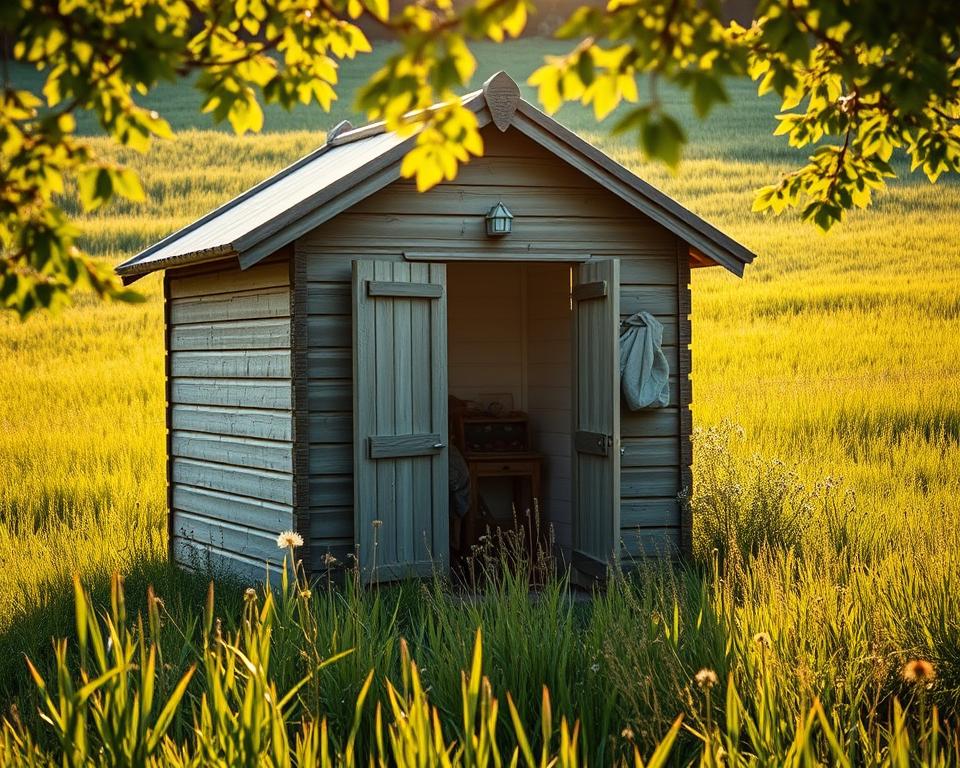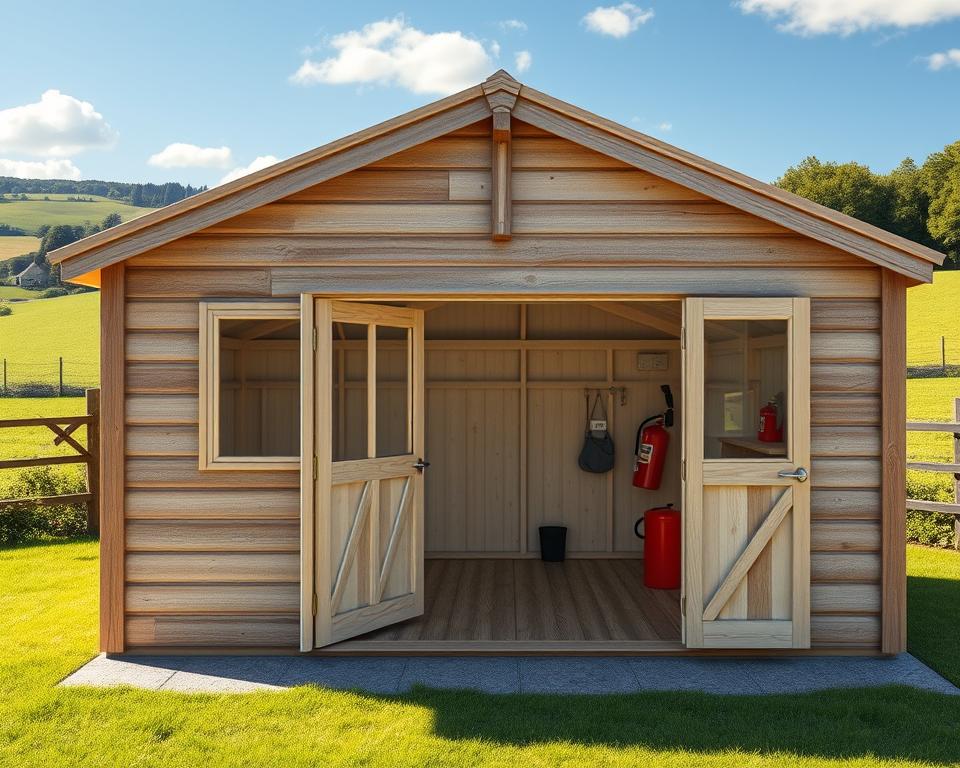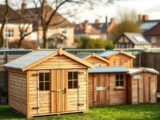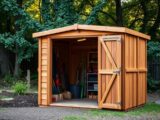Can You Sleep in a Shed in the UK? – Legal Guidelines

Exploring alternative living spaces has become increasingly popular, with many people considering UK shed laws as a potential housing solution. Sleeping in sheds might seem like an innovative way to maximise garden space, but navigating the complex garden building regulations requires careful consideration.
The United Kingdom has specific legal frameworks governing residential structures, including outbuildings. Homeowners and renters must understand the intricate requirements before transforming a simple garden shed into a living space. Safety, planning permissions, and local authority regulations play crucial roles in determining whether sleeping in sheds is permissible.
This comprehensive guide will walk you through the essential legal considerations, helping you understand the potential and limitations of using a shed as an accommodation option in the UK.
Inhaltsverzeichnis
Key Takeaways
- Understand complex UK shed laws before converting
- Check local authority planning permissions
- Assess safety and building regulation compliance
- Consider structural and amenity requirements
- Evaluate potential legal implications
Understanding UK Planning Laws for Shed Usage
Navigating the complex landscape of UK planning laws can be challenging for homeowners considering shed conversions. The regulations surrounding permitted development rights and building regulations are crucial to understand before transforming any outbuilding into a habitable space.
Homeowners must carefully examine the specific guidelines that govern shed usage and potential residential adaptations. UK planning laws provide a framework that balances individual property rights with broader community considerations.
Exploring Permitted Development Rights
Permitted development rights offer some flexibility for property owners, but they come with important restrictions:
- Maximum height limitations for outbuildings
- Specific size constraints for garden structures
- Distance requirements from property boundaries
- Restrictions on total coverage of garden area
Building Regulations for Residential Structures
When considering a shed as a potential living space, building regulations become critical. These standards ensure:
- Structural integrity of the building
- Adequate insulation and weatherproofing
- Proper electrical and plumbing installations
- Compliance with fire safety standards
Local Authority Requirements
Each local council may interpret UK planning laws slightly differently. Proactive communication with your local planning department is essential. They can provide specific guidance about:
- Potential planning permission needs
- Specific zoning restrictions
- Conservation area considerations
- Neighbour consultation requirements
Always verify local regulations before making any structural changes to your property.
Legal Implications of Converting a Shed for Sleeping

Navigating the shed conversion legalities in the UK requires careful understanding of residential use of outbuildings. Property owners must recognise the complex landscape of UK housing laws before transforming a garden shed into a sleeping space.
The legal ramifications of shed conversion can be significant. Local authorities scrutinise the intended use of outbuildings, distinguishing between occasional recreational use and potential permanent residential occupation.
- Planning permission becomes critical for substantial structural changes
- Building regulations mandate specific safety and habitability standards
- Potential breaches can result in enforcement actions
Homeowners should consider several key legal aspects:
| Legal Consideration | Potential Consequences |
|---|---|
| Unauthorised Residential Use | Potential fines up to £50,000 |
| Building Regulation Violations | Enforcement notices and mandatory modifications |
| Insurance Implications | Potential policy invalidation |
Consulting local planning authorities before commencing any shed conversion is crucial to ensure compliance with current UK housing regulations.
“Always verify your specific local guidelines before making significant changes to outbuildings.” – Royal Town Planning Institute
Can You Sleep in a Shed in the UK?
Navigating the complex landscape of temporary shed accommodation requires careful consideration of legal and practical aspects. Homeowners and residents often wonder about the possibilities and limitations of using sheds as sleeping spaces in the United Kingdom.

Understanding the nuanced regulations surrounding shed usage is crucial for anyone contemplating alternative housing solutions.
Temporary vs Permanent Occupancy
The distinction between temporary and permanent occupancy is fundamental when exploring shed accommodation. Emergency housing options may provide more flexibility, but permanent residence demands stringent compliance with building regulations.
- Temporary occupancy might be permitted for short-term situations
- Permanent living requires comprehensive planning permission
- Duration of stay significantly impacts legal considerations
Emergency Housing Considerations
In exceptional circumstances, garden room regulations might offer alternative solutions for urgent housing needs. Local authorities may provide guidance on temporary accommodation scenarios.
| Scenario | Potential Approval | Key Considerations |
|---|---|---|
| Domestic Emergency | Potentially Permitted | Must meet safety standards |
| Renovation Period | Likely Approved | Temporary nature is crucial |
| Family Accommodation | Restricted | Requires detailed planning |
Garden Room Classifications
Garden rooms present a unique category within shed accommodation. These structures often have different regulatory requirements compared to traditional garden sheds.
“Garden rooms must meet specific building standards to be considered habitable,” advises urban planning expert Sarah Richardson.
- Must comply with permitted development rights
- Require proper insulation and utility connections
- Subject to local authority building regulations
Ultimately, successful shed accommodation depends on meticulous planning, legal compliance, and a clear understanding of local guidelines.
Safety Requirements for Habitable Outbuildings

Creating a safe living space in an outbuilding requires careful attention to UK building safety standards. Transforming a shed into a habitable space involves meeting specific outbuilding safety standards that protect occupants from potential risks.
Structural integrity forms the foundation of habitable shed requirements. Key safety considerations include:
- Robust foundation to prevent moisture penetration
- Adequate waterproofing and damp-proofing
- Strong roof construction with no leaks
- Secure windows and doors
Electrical safety is crucial for any habitable outbuilding. Occupants must ensure:
- Professional electrical installations
- Proper earthing and circuit protection
- Regular electrical safety inspections
- Compliance with current wiring regulations
Ventilation and thermal efficiency play vital roles in creating a safe living environment. Proper insulation prevents condensation, reduces fire risks, and maintains comfortable living conditions. Implementing adequate ventilation helps prevent mould growth and ensures air quality.
Safety isn’t just about regulations—it’s about creating a secure and comfortable living space.
Fire safety measures are non-negotiable. Install smoke detectors, fire extinguishers, and ensure clear emergency exit routes. Local authorities often have specific guidelines for transforming outbuildings into legal living spaces.
Essential Amenities for Legal Shed Accommodation
Transforming a shed into a habitable space requires careful planning and attention to critical safety and comfort standards. Homeowners must navigate a complex landscape of regulations to ensure their outbuilding meets legal requirements for living spaces.
Ensuring a shed becomes a safe and comfortable living environment involves addressing several key amenities that go beyond basic construction.
Ventilation and Insulation Standards
Shed insulation plays a crucial role in creating a liveable space. Proper thermal regulation prevents moisture buildup and maintains comfortable internal temperatures. Key considerations include:
- Installing high-quality insulation materials
- Ensuring adequate air circulation
- Preventing condensation and dampness
Electrical Safety in Outbuildings
Electrical safety in outbuildings demands professional expertise. Critical requirements include:
- Certified electrical installations
- Appropriate circuit protection
- Earthing and surge protection systems
Fire Safety for Garden Rooms
Fire safety represents a paramount concern for any habitable shed. Implementing comprehensive protection measures is non-negotiable:
- Install smoke and carbon monoxide detectors
- Use fire-resistant building materials
- Maintain clear emergency exit routes
Professional assessment remains essential to guarantee your shed meets all necessary safety and legal standards for residential use.
Alternative Legal Options for Shed Usage

Garden buildings offer exciting possibilities beyond traditional storage solutions. UK outdoor living spaces provide creative opportunities for homeowners to maximise their property’s potential through legal shed uses and alternative garden building options.
Residents can transform garden structures into versatile spaces that enhance property value and lifestyle:
- Home office workspace
- Art studio or creative retreat
- Fitness and wellness area
- Entertainment and relaxation zone
Different legal shed uses can serve specific functional needs while complying with local planning regulations. Homeowners should consider their specific requirements and local authority guidelines when planning alternative garden building options.
| Shed Purpose | Potential Benefits | Planning Considerations |
|---|---|---|
| Home Office | Increased productivity | Permitted development rights |
| Art Studio | Creative workspace | Size and height restrictions |
| Fitness Area | Personal wellness | Electrical and ventilation requirements |
When exploring UK outdoor living spaces, always prioritise legal compliance and structural integrity. Consulting local planning authorities can help ensure your garden building meets all necessary regulations.
Common Mistakes to Avoid When Converting Sheds

Transforming a shed into a functional living space requires careful planning and attention to detail. Many homeowners encounter significant challenges when attempting shed conversions without proper preparation. Understanding potential shed conversion mistakes can save you time, money, and legal headaches.
Navigating the complex landscape of shed transformations involves multiple critical considerations that could derail your project if overlooked.
Planning Permission Violations
Planning permission errors represent a substantial risk for shed conversion projects. Local authorities have strict guidelines about outbuilding modifications:
- Exceeding maximum height restrictions
- Covering too much of your property’s ground space
- Constructing within prohibited distance from property boundaries
- Failing to obtain necessary documentation
Building Code Infractions
Building code infractions can create serious legal and safety challenges. Critical areas of concern include:
- Inadequate structural reinforcement
- Poor electrical system integration
- Insufficient insulation standards
- Lack of proper ventilation
Insurance Considerations
Outbuilding insurance becomes complex when converting a shed for habitation. Homeowners must carefully review their existing policies to understand potential coverage gaps.
| Insurance Aspect | Potential Risks | Recommended Action |
|---|---|---|
| Standard Policy Coverage | Limited protection for converted spaces | Request specific outbuilding rider |
| Structural Modifications | Potential policy invalidation | Notify insurer of all changes |
| Liability Protection | Increased personal risk | Extend personal liability coverage |
Professional consultation with local planning authorities and insurance providers is crucial to mitigate potential risks in shed conversion projects.
Proper Steps to Legalise Shed Accommodation
Navigating the legalising shed living process requires careful planning and attention to detail. Homeowners interested in converting their garden structures must understand the proper shed conversion process to ensure compliance with local regulations.
Before beginning any transformation, research your local authority’s specific requirements for UK garden building permits. Each council has unique guidelines that must be carefully followed to avoid potential legal complications.
- Conduct a thorough site survey of your garden and existing shed
- Measure the proposed living space precisely
- Check specific local planning restrictions
- Prepare detailed architectural drawings
The key documentation for legalising shed accommodation typically includes:
| Document Type | Purpose | Required Details |
|---|---|---|
| Site Plan | Location verification | Property boundaries, shed dimensions |
| Structural Assessment | Building safety | Insulation, foundation, materials |
| Utility Compliance | Service connections | Electrical, water, drainage plans |
Professional guidance can significantly streamline the permit application process. Consider consulting a local planning expert who understands the nuanced requirements for residential outbuilding conversions.
Remember that patience and meticulous documentation are crucial when pursuing legal shed accommodation. By following official channels and maintaining transparent communication with local authorities, you can successfully transform your garden shed into a compliant living space.
Conclusion
Exploring legal shed accommodation in the UK requires careful consideration of garden building regulations. Understanding the complex landscape of UK shed living laws is crucial for anyone contemplating transforming an outbuilding into a habitable space.
Local authorities have specific guidelines that must be meticulously followed. Potential residents need to research planning permissions, building regulations, and safety standards before converting a shed into a living area. Professional consultation can help navigate these intricate legal requirements and ensure compliance with current housing regulations.
Safety remains paramount when considering alternative living spaces. While garden buildings offer innovative housing solutions, they must meet rigorous standards for electrical systems, ventilation, insulation, and fire protection. Residents should prioritise professional assessments and obtain necessary permissions to create a legally compliant and secure living environment.
The journey to legal shed accommodation demands patience, research, and professional guidance. By understanding local regulations and investing in proper modifications, individuals can transform their garden structures into safe, comfortable living spaces that meet all UK housing standards.
FAQ
Is it legal to sleep in a shed in the UK?
The legality of sleeping in a shed depends on several factors, including planning permissions, building regulations, and the intended use. Temporary occasional use might be permissible, but permanent occupancy typically requires formal planning consent and meeting specific safety standards.
Do I need planning permission to convert my shed into a sleeping area?
In most cases, you will need to obtain planning permission from your local authority. Permitted development rights have strict limitations, and converting a shed for residential use often requires formal approval to ensure it meets building regulations and safety standards.
What safety requirements must a shed meet for habitation?
A shed must meet several critical safety standards, including structural integrity, proper insulation, adequate ventilation, electrical safety, fire protection, and appropriate plumbing facilities. These requirements ensure the space is safe and legally habitable.
Can I use my shed as emergency housing?
Emergency housing situations may have slightly different considerations, but you’ll still need to ensure the shed meets basic safety and health standards. Local authorities might provide temporary guidance for crisis accommodation, but long-term use requires full compliance with building regulations.
How will converting a shed affect my home insurance?
Converting a shed can significantly impact your home insurance policy. Most standard policies won’t cover unauthorised residential structures, so you’ll need to inform your insurance provider and potentially obtain additional coverage for any modifications.
What are the potential consequences of illegally converting a shed?
Illegal shed conversion can result in significant penalties, including enforcement notices from local authorities, potential fines, mandatory restoration to original condition, and complications with property sales or insurance claims.
Are there alternative legal uses for my garden shed?
Absolutely! You can legally use a shed as a home office, art studio, storage space, garden workshop, or recreational room without the complex regulations associated with residential accommodation.
What documentation do I need to legalise shed accommodation?
You’ll typically need detailed plans, structural assessment reports, compliance certificates for electrical and plumbing work, building regulation approvals, and local authority permissions to legally convert a shed for sleeping purposes.
How do garden rooms differ from sheds in terms of residential use?
Garden rooms are typically constructed to higher building standards and may have more lenient planning permissions compared to traditional sheds. They’re often purpose-built with better insulation, electrical provisions, and structural integrity.
What should I consider before attempting to sleep in my shed?
Consider local regulations, safety standards, structural integrity, insulation, electrical safety, ventilation, potential insurance implications, and always consult with local authorities and professional builders before making any modifications.

